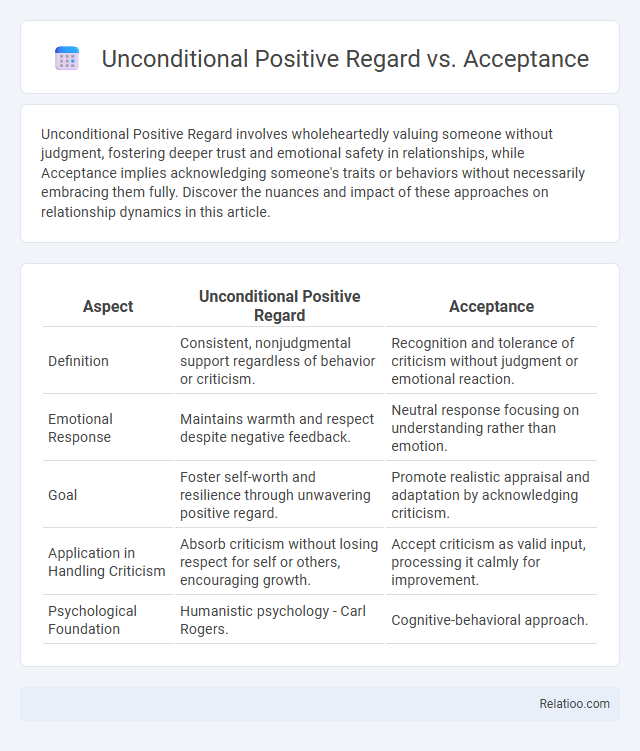Unconditional Positive Regard involves wholeheartedly valuing someone without judgment, fostering deeper trust and emotional safety in relationships, while Acceptance implies acknowledging someone's traits or behaviors without necessarily embracing them fully. Discover the nuances and impact of these approaches on relationship dynamics in this article.
Table of Comparison
| Aspect | Unconditional Positive Regard | Acceptance |
|---|---|---|
| Definition | Consistent, nonjudgmental support regardless of behavior or criticism. | Recognition and tolerance of criticism without judgment or emotional reaction. |
| Emotional Response | Maintains warmth and respect despite negative feedback. | Neutral response focusing on understanding rather than emotion. |
| Goal | Foster self-worth and resilience through unwavering positive regard. | Promote realistic appraisal and adaptation by acknowledging criticism. |
| Application in Handling Criticism | Absorb criticism without losing respect for self or others, encouraging growth. | Accept criticism as valid input, processing it calmly for improvement. |
| Psychological Foundation | Humanistic psychology - Carl Rogers. | Cognitive-behavioral approach. |
Understanding Unconditional Positive Regard
Understanding unconditional positive regard involves recognizing its core as offering unwavering support and empathy without judgment, fostering a safe environment for personal growth. Unlike general acceptance, which may be conditional or situational, unconditional positive regard emphasizes consistent validation of Your intrinsic worth regardless of actions or circumstances. This therapeutic concept, rooted in Carl Rogers' humanistic psychology, promotes self-awareness and resilience by affirming You as inherently valuable.
Defining Acceptance in Relationships
Acceptance in relationships involves recognizing and valuing Your partner's true self without judgment or attempts to change them. It differs from unconditional positive regard by emphasizing genuine acknowledgment of feelings and behaviors, rather than solely offering nonjudgmental support. This form of acceptance fosters emotional safety and trust, crucial for deep and lasting connections.
Historical Roots: Origins of Both Concepts
Unconditional Positive Regard (UPR), formulated by psychologist Carl Rogers in the 1940s, originated from humanistic psychology emphasizing non-judgmental acceptance in therapeutic relationships to foster personal growth. Acceptance, while related, has broader philosophical and cultural roots, encompassing various traditions such as Buddhism and existentialism that highlight embracing experiences without resistance. The distinction lies in UPR's clinical framework focusing on therapist-client dynamics, whereas acceptance broadly addresses an individual's attitude toward internal states and external realities.
Core Principles and Differences
Unconditional Positive Regard (UPR) emphasizes nonjudgmental support and complete acceptance of a person's feelings and behaviors, fostering personal growth and self-worth without conditions. Acceptance involves acknowledging reality and emotions without resistance but may include setting boundaries or conditions, differentiating it from UPR's total affirmation. Core principles of UPR center on empathy, congruence, and genuine care, while acceptance prioritizes mindfulness and tolerance, highlighting a fundamental difference in therapeutic approaches.
Psychological Impact and Benefits
Unconditional Positive Regard fosters deep psychological safety by promoting self-acceptance and reducing anxiety, thereby enhancing self-esteem and emotional resilience. Acceptance emphasizes acknowledging feelings and experiences without judgment, which supports emotional regulation and mental well-being. The psychological benefits of Unconditional Positive Regard include improved interpersonal relationships, greater empathy, and increased motivation for personal growth.
Applications in Therapy and Counseling
Unconditional Positive Regard (UPR) is a cornerstone in person-centered therapy that fosters a nonjudgmental, empathetic environment allowing clients to explore their feelings without fear of rejection. Acceptance in therapy often involves acknowledging clients' experiences and emotions without attempting to change them, promoting self-awareness and emotional healing. Your therapeutic progress benefits significantly when UPR and acceptance are applied together, as they create a safe space for authentic self-expression and psychological growth.
Unconditional Positive Regard vs Acceptance: Key Distinctions
Unconditional Positive Regard involves accepting and valuing Your thoughts and feelings without judgment, fostering a therapeutic environment where genuine growth occurs. Acceptance, while similar, emphasizes acknowledging experiences and emotions as they are, without necessarily attaching positive evaluation. The key distinction lies in Unconditional Positive Regard's focus on inherent worth and support, whereas Acceptance centers on openness and tolerance of internal states.
Challenges and Criticisms of Each Approach
Unconditional Positive Regard faces challenges related to potential enabling of harmful behaviors, making it difficult to balance support with accountability in therapeutic settings. Acceptance can be criticized for promoting complacency or resignation, potentially hindering personal growth when difficulties are simply tolerated without active change. Your emotional well-being may be impacted by these approaches' limitations, as excessive acceptance or unconditional support can sometimes neglect the necessity for boundaries and constructive feedback.
Real-Life Examples and Case Studies
Unconditional Positive Regard, a concept developed by Carl Rogers, involves accepting and valuing a person without judgment, often demonstrated in therapy by creating a safe environment where clients feel genuinely understood. In contrast, Acceptance refers more broadly to recognizing and allowing experiences, thoughts, and feelings without trying to change or resist them, as seen in Acceptance and Commitment Therapy (ACT) techniques used to manage anxiety and depression. Case studies reveal that clients receiving Unconditional Positive Regard report increased self-esteem and trust in therapeutic relationships, while Acceptance-based interventions enhance emotional regulation and resilience in everyday challenges.
Choosing the Right Approach for Growth
Choosing the right approach for growth involves understanding the nuances between unconditional positive regard, acceptance, and unconditional positive regard in therapy and personal development. Unconditional positive regard emphasizes non-judgmental support regardless of behaviors, fostering trust and self-exploration, while acceptance involves acknowledging your feelings and experiences without resistance, promoting emotional resilience. Your growth is best supported by blending these approaches to create a foundation of empathy, validation, and openness that encourages authentic self-improvement.

Infographic: Unconditional Positive Regard vs Acceptance
 relatioo.com
relatioo.com